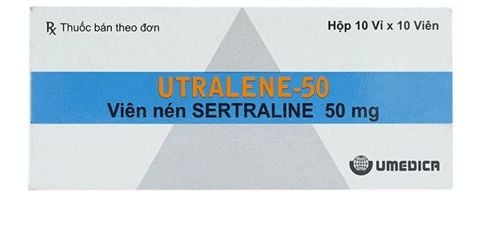This is an automatically translated article.
Diclofenac belongs to the group of non-steroidal anti-inflammatory drugs (NSAIDs). The drug is indicated for the treatment of pain and inflammation. Compliance with indications and doses of Diclofenac will help patients improve treatment effectiveness and avoid unwanted side effects.1. What is Diclofenac?
Diclofenac contains the main ingredient Diclofenac 20mg and other excipients just enough provided by the manufacturer. The dosage form of the drug is a transparent, colorless and homogeneous skin ointment contained in an aluminum tube, packaged in 10g, 20g, 30g tubes. Diclofenac works by inhibiting the action of the enzyme cyclooxygenase (COX) present in the body. This enzyme is involved in many different synthesis processes in the body, some of which are known as prostaglandins. Prostaglandins are produced by the body in response to injury, in pathological conditions and conditions that cause swelling, pain, and inflammation. Diclofenac inhibits the biosynthesis of these prostaglandins and thus has analgesic and anti-inflammatory effects.
2. What does Diclofenac do?
Diclofenac is indicated for the local symptomatic relief of pain and inflammation in the following cases:Injuries to tendons, ligaments, muscles and joints such as sprains, dislocations and bruises. Local treatment of rheumatic diseases in the soft tissue part. After 14 days of treatment with Diclofenac, the patient should be evaluated and reassessed the response to this drug when used to treat the above conditions. Similar to the case of chronic arthritis with superficial joints such as the knee, it is also necessary to re-evaluate after 14 days of treatment.
In addition, Diclofenac is contraindicated in the following cases:
The patient is allergic to the active ingredient Diclofenac, Acetylsalicylic acid, other non-steroidal anti-inflammatory drugs or any ingredients in the drug.
3. Dosage and how to use Diclofenac
Diclofenac is available in the form of a topical ointment. Patients apply the medicine gently on the skin to be treated, avoid applying too much force to damage the surrounding skin. Patients should wash their hands thoroughly before applying the medicine and wash their hands after application, except for the case of the skin to be treated on the hands. Take out an appropriate amount of medicine according to the size of the skin to be applied. Avoid applying the drug to mucosal areas such as eye mucosa, tongue mucosa, ... In case the drug gets on the upper mucosa areas, it should be washed under running water immediately.For adults, it can be applied 3-4 times a day, about 2-4g each time, depending on the size of the painful area.
Children are not recommended to use Diclofenac because the dosage and indications for this class of drugs have not been established.
Note: The above is just the manufacturer's recommended dosage. Depending on the different medical conditions, the doctor will base on that to prescribe the appropriate use with the appropriate dose and concentration. Patients should strictly follow the doctor's instructions before taking the drug.
4. Diclofenac side effects
Doctors always consider between the benefits that Diclofenac brings to the patient and the possible risk of side effects to prescribe the appropriate medication.
Diclofenac can cause side effects at the site of application.
Some of the side effects that have been reported include:
Allergic skin reactions. Contact dermatitis, rash, dry skin or scaling. Sensitivity to light such as a rash. In the case of using Diclofenac on a large area of the skin and for a long time, there may be a risk of unwanted systemic effects. Note: The unwanted effects will disappear when the drug is stopped. In addition to the side effects listed above, Diclofenac may cause other unwanted effects that have not been fully identified. Therefore, tell your doctor immediately if you notice any side effects that are suspected to be related to the medicine you are taking Diclofenac.
5. Diclofenac drug interactions
To date, no drug interactions have been reported when using Diclofenac with other drugs. However, this drug should not be used in combination with other medicines containing the active ingredient Diclofenac and should be used with caution when used in combination with oral non-steroidal anti-inflammatory drugs because of the potential for increased risk of adverse effects. undesirable for the patient.
The extent of safety and effectiveness when Diclofenac is used concomitantly with topical preparations (eg, sunscreens, cosmetics, other topical medications) is not known.
6. Notes when using Diclofenac
Some notes when patients use Diclofenac medicine as follows:
The drug is only applied to the skin, avoid applying to the eyes and mucous membranes. Do not apply the medicine to open wounds, infected skin or scaly skin. A small number of patients may experience a sensitive reaction such as anaphylaxis if they have never taken Diclofenac before. Caution should be exercised in patients on aspirin triad, as Diclofenac contains an ester derivative of parahydroxybenzoate with potential (possibly delayed) allergic reactions. The patient takes the medicine exactly as directed by the doctor. The drug should not be stopped abruptly when clinical symptoms have improved. Take the medicine exactly as prescribed by your doctor. Before using the medicine, check the expiration date written on the outside of the packaging, if the expiry date has expired, it should not be used. The medicine should be stored in a cool, dry place, away from heat and direct light. Once used up, the patient should throw away the tube after the course of treatment within 5 days, even if there is still some medicine left. Do not leave the tube open if you want to use it next time. Disposable medicines should be used as soon as the tube is opened. The patient should not store or reuse the opened ampoules for the next dose as these do not contain preservatives. Pregnant women: Diclofenac can cross the placental barrier, so there is a risk of affecting the fetus, miscarriage, malformation,... Especially if the pregnant patient takes the drug in the last 3 months of pregnancy. of pregnancy may carry a risk of premature closure of the ductus arteriosus. Avoid taking the drug in the last days of pregnancy as it may delay labor or premature delivery. Therefore, this drug should only be used in pregnant women when prescribed by a doctor and absolutely necessary during treatment, considering the benefits of treatment for the mother and the potential risk to the fetus. . Breast-feeding: There have been no studies on the safety of this medication in nursing women. In case a nursing patient must take Diclofenac, breast-feeding may be discontinued before starting treatment.
7. What to do in case of missed dose or overdose of Diclofenac?
When the patient forgets to take Diclofenac, take the dose as soon as he remembers. The drug can be taken about 1-2 hours after the daily scheduled dosing time without affecting the treatment. The missed dose may be skipped when it is almost time for the next scheduled dose. Do not take a double dose to make up for a missed dose, which can lead to an overdose. Although the drug Diclofenac is used topically, the ability to absorb the system is low. If Diclofenac accidentally overdosed as directed by the treating doctor or accidentally took it can cause serious systemic unwanted effects, the patient should stop taking the drug immediately, self-monitor the effects. Other side effects may occur. When the symptoms become more severe, it is necessary to take the patient to the hospital immediately for timely treatment to prevent complications. Patients should also remember to bring used medicines with them so that the doctor can understand the information and handle it quickly and promptly. The above article has given relevant information on usage, uses, dosage and some notes when using Diclofenac. While taking the drug, the patient should follow the doctor's instructions. Note, Diclofenac is a prescription drug, patients can only use this drug when prescribed by a specialist.













